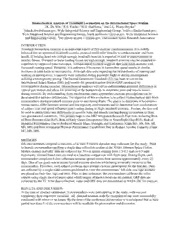
NASA Technical Reports Server (NTRS) 20110023081: Biomechanical Analysis of Treadmill Locomotion on the International Space Station PDF
Preview NASA Technical Reports Server (NTRS) 20110023081: Biomechanical Analysis of Treadmill Locomotion on the International Space Station
Biomechanical Analysis of Treadmill Locomotion on the International Space Station J.K. De Witt,1 R.S. Fincke,2 M.E. Guilliams,3 and L.L. Ploutz-Snyder6 [email protected], Wyle Integrated Science and Engineering Group, [email protected], Wyle Integrated Science and Engineering Group, [email protected], Wyle Integrated Science and Engineering Group, [email protected], Universities Space Research Association INTRODUCTION Treadmill locomotion exercise is an important aspect of ISS exercise countermeasures. It is widely believed that an optimized treadmill exercise protocol could offer benefits to cardiovascular and bone health. If training heart rate is high enough, treadmill exercise is expected to lead to improvements in aerobic fitness. If impact or bone loading forces are high enough, treadmill exercise may be expected to contribute to improved bone outcomes. Ground-based research suggests that joint loads increase with increased running speed. However, it is unknown if increases in locomotion speed results in similar increases in joint loads in microgravity. Although data exist regarding the biomechanics of running and walking in microgravity, a majority were collected during parabolic flight or during investigations utilizing a microgravity analog. The Second Generation Treadmill (T2) has been in use on the International Space Station (ISS) and records the ground reaction forces (GRF) produced by crewmembers during exercise. Biomechanical analyses will aid in understanding potential differences in typical gait motion and allow for modeling of the human body to determine joint and muscle forces during exercise. By understanding these mechanisms, more appropriate exercise prescriptions can be developed that address deficiencies. The objective of this evaluation is to collect biomechanical data from crewmembers during treadmill exercise prior to and during flight. The goal is to determine if locomotive biomechanics differ between normal and microgravity environments and to determine how combinations of subject load and speed influence joint loading during in-flight treadmill exercise. Further, the data will be used to characterize any differences in specific bone and muscle loading during locomotion in these two gravitational conditions. This project maps to the HRP Integrated Research Plan risks including Risk of Bone Fracture (Gap B15), Risk of Early Onset Osteoporosis Due to Spaceflight (Gap B15), Risk of Impaired Performance Due to Reduced Muscle Mass, Strength, and Endurance (Gaps M3, M4, M6, Ml, M8, M9) and Risk of reduced Physical Performance Capabilities Due to Reduce Aerobic Capacity (Gaps M7, M8, M9). METHODS ISS crewmembers assigned to missions of at least 5 months duration may volunteer for this study. Prior to launch, crewmembers perform a single data collection session at the NASA Johnson Space Center. Motion capture and GRF data are collected for 30 s at speeds ranging from 1.5-9.5 mph in 0.5 mph increments. Ground based data are used as a baseline comparison with flight data. During flight, each crewmember completes 6 data collection sessions spread across their mission approximately every 25 days. One of our goals was to assess typical exercise sessions while being minimally intrusive to the crewmember. Therefore, each subject performs their normal exercise prescription for the test day. Data are collected by a single video camera positioned to view the crewmembers’ left side, and tape markers are placed on their feet, legs and neck. Prior to data collection, the crewmembers calibrate the video camera using single sheet of paper upon which targets of known locations are printed. GRF data are collected by the T2. After data collection, video and GRF data are downlinked to NASA JSC for analysis. RESULTS AND DISCUSSION At the time of abstract submission, 3 crewmembers were participating in the study, with one just completing their respective missions. All planned sessions with the exception of one were successfully conducted with minor or no issues. By the time of the conference presentation it is anticipated that at least partial sets from 3 of the crewmembers will be available for presentation and discussion.
